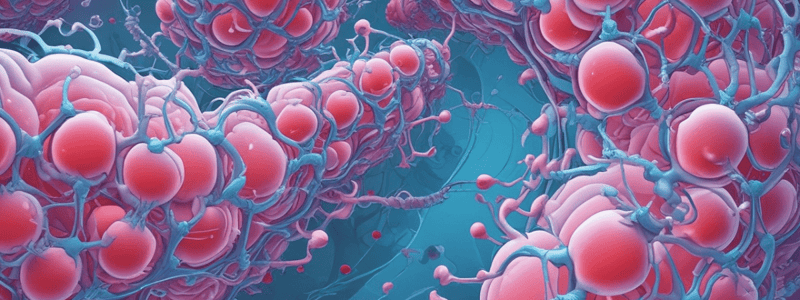Podcast
Questions and Answers
What is the size range of a typical animal cell?
What is the size range of a typical animal cell?
- 10-20µm
- 20-30µm (correct)
- 100-150µm
- 50-60µm
What is the oldest technique used to examine living cells?
What is the oldest technique used to examine living cells?
- Cell culture
- Electron microscopy
- Direct observation under a microscope (correct)
- Cell fractionation
What is the purpose of using a culture media in cell culture?
What is the purpose of using a culture media in cell culture?
- To isolate the cells
- To study the cell wall
- To keep the cells alive (correct)
- To kill the cells
Who is credited with the first tissue culture in 1907?
Who is credited with the first tissue culture in 1907?
What was the first culture media used by Ross Harrison?
What was the first culture media used by Ross Harrison?
What is the purpose of isolating cells and growing them in culture?
What is the purpose of isolating cells and growing them in culture?
What can be observed in a cell culture of spinal cord fragments?
What can be observed in a cell culture of spinal cord fragments?
What is the advantage of using cell culture over direct observation of living cells?
What is the advantage of using cell culture over direct observation of living cells?
What is the ideal temperature for cell cultivation in a CO2 incubator?
What is the ideal temperature for cell cultivation in a CO2 incubator?
What is the purpose of the indicator dye phenol red in cell culture?
What is the purpose of the indicator dye phenol red in cell culture?
What is the main characteristic of a primary cell culture?
What is the main characteristic of a primary cell culture?
What is the term for a process where cells stop dividing and die?
What is the term for a process where cells stop dividing and die?
What is the main advantage of using cell cultures in research?
What is the main advantage of using cell cultures in research?
What is the term for a cell that has undergone transformation and can grow indefinitely?
What is the term for a cell that has undergone transformation and can grow indefinitely?
What is the purpose of a laminar-flow hood in cell culture?
What is the purpose of a laminar-flow hood in cell culture?
What is the term for a culture derived from a single transformed cell?
What is the term for a culture derived from a single transformed cell?
What is the main purpose of microdissection techniques in cell biology?
What is the main purpose of microdissection techniques in cell biology?
What is the significance of embryonic stem cells in cell biology?
What is the significance of embryonic stem cells in cell biology?
What is the primary application of cell culture in cancer research?
What is the primary application of cell culture in cancer research?
What is the main feature of hybrid cells?
What is the main feature of hybrid cells?
What is the process of cell fusion?
What is the process of cell fusion?
Which of the following organisms is widely used in molecular biology research?
Which of the following organisms is widely used in molecular biology research?
What is the significance of Saccharomyces cerevisiae in molecular biology research?
What is the significance of Saccharomyces cerevisiae in molecular biology research?
What is the potential application of embryonic stem cells in therapy?
What is the potential application of embryonic stem cells in therapy?
Flashcards are hidden until you start studying
Study Notes
Microdissection Techniques
- Allow selected cells to be isolated from tissue slices
- Applications include:
- Embryonic organ culture
- Study of cancer cells
- Cell-virus relations
- Cytogenetic research
- Cell-cell interactions
- Cell nutrition
Embryonic Stem Cells
- Most promising cell lines for medical applications
- Derived from inner cell mass of early mouse embryos
- Can proliferate indefinitely
- Can give rise to all cell types in the body
- Can be used to replace and repair damaged mature human tissues
- Potential therapeutic applications:
- Muscular dystrophy
- Parkinson's disease
- Type I diabetes
Model Organisms
- Escherichia coli (E. coli): best understood cell in biology
- Saccharomyces cerevisiae (yeast): most frequently used single-cell eukaryote
- Studies with bacteria and yeast established basic principles of molecular biology
Cell-Cell Fusion
- Hybrid cells produced by fusion of animal cells
- Cell fusion: membrane merging and cytoplasmic mixing of two cell types
- Examples: human cell and mouse cell fusion
Cell Size and Number
- Human body composed of trillions of cells
- Size of a typical animal cell: 20-30 µm
- Largest cell: human egg (150-200 µm)
- Smallest cell: granular cells of cerebellum (4-5 µm)
Methods for Examining Cells
- Examination of the cell as a whole (without disruption)
- Examination of living cells (fresh tissues)
- Examination of killed and preserved tissues and cells
- Fractionation of cells and analyzing their molecules
Cell Culture
- Isolating cells and growing them in culture
- Living cells can be suspended in an appropriate liquid (e.g. saline solution)
- Prolonged study of living cells can be made by culturing them in solutions containing necessary nutrients
- First tissue culture (1907): Ross Harrison, isolated fragments of spinal cord of a frog
Culture Conditions
- Medium supplying essential nutrients (amino acids, carbohydrates, vitamins, minerals)
- Growth factors
- Hormones
- Gases (O2, CO2)
- Regulated physico-chemical environment (pH, osmotic pressure, temperature)
- Most cells are anchorage-dependent and require a solid or semi-solid substrate
Primary Cell Culture and Cell Lines
- Primary cell culture: derived from normal animal cells, limited life span, divide 25-50 times, and then stop dividing (cell senescence)
- Cell lines: eukaryotic cell lines, widely used for experiments, transformed cells, grow indefinitely in culture (immortal cells)
Studying That Suits You
Use AI to generate personalized quizzes and flashcards to suit your learning preferences.




